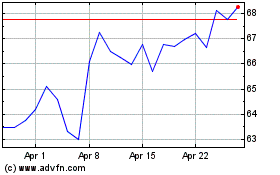Rio Pares Output of Less-Sparkling Niche Commodities -- Update
October 15 2015 - 8:11PM
Dow Jones News
By Rhiannon Hoyle
SYDNEY--Rio Tinto PLC's shipments of iron ore have surged,
although the mining giant is dialing back production of some niche
commodities such as diamonds and salt amid broad-based weakness in
commodity markets.
Mining companies around the world have been put on the back foot
by slumping prices for natural resources from gemstones to copper
and coal thanks to ample global supplies and slowing economic
growth. In some sectors, companies have pared output in the hope
markets would rebalance, while in others miners have raced to cut
costs with the aim of riding out the downturn.
On Friday, Rio Tinto said it has decided "to pause final product
processing in the fourth quarter at Argyle in light of current
market conditions."
Rio Tinto's Argyle operation in the remote East Kimberley region
of Western Australia is one of the world's largest diamond mines
and the biggest supply of natural-colored pink and red
diamonds.
The miner now expects to produce 18 million carats of diamonds
this year, from a prior estimate of 20 million.
It has also pared back output of salt, a commodity used heavily
by the chemical industry and also sold to food manufacturers. Rio
Tinto is one of the world's biggest suppliers in that market too.
"Salt production in the first nine months of 2015 was lower than
the same period of 2014 as a result of weaker demand," the company
said, without elaborating.
In small commodity markets, dominant producers tend to be
quicker to adjust output in line with demand. It is the same
strategy adopted by companies such as Iluka Resources Ltd., a major
producer in the niche mineral sands industry, which in recent years
curbed output of those raw materials used in items such as plastics
and ceramics as demand tumbled.
Large global miners including Glencore PLC have cut their own
production of commodities from zinc to copper in recent weeks due
to oversupply and weak prices in those markets.
Australia's Macquarie Group said Rio's production of commodities
such as diamonds and salt was well below its expectations. "Rio has
reacted to weaker demand for some of these products," it said in a
note.
It isn't a tack Rio Tinto has taken in iron ore, which accounts
for the majority of its earnings and where it has drawn ire from
some smaller rivals and politicians who say the miner and some of
its peers are devastating the once-thriving industry by flooding
the market.
The Anglo-Australian miner reported global iron-ore shipments of
91.3 million metric tons for the three months through September, up
12% on the quarter immediately prior and 17% higher than the same
period a year ago.
Rio Tinto, the world's second-largest exporter of iron ore, has
been expanding its own network of mines and infrastructure in
Australia's remote, iron-rich Pilbara region in recent years,
despite a downturn in market prices. The company expects to ship
340 million tons of the steelmaking commodity this year from its
operations in Australia and Canada, up from 303 million tons in
2014.
It has repeatedly defended its strategy to keep increasing
production, first outlined when prices were booming on China's
breakneck growth. Rio's iron-ore chief executive, Andrew Harding,
has argued the miner is operating in "a competitive, international
marketplace" and that other miners would increase their own
production if his unit was to curb output.
Iron-ore prices have meanwhile tumbled 60% since the start of
last year due to ample supplies and China's economic slowdown.
Analysts have been forecasting a further fall in the iron-ore price
on the expectation Asia's appetite for the commodity won't be
enough to soak up rising supplies, including from billionaire Gina
Rinehart's new 55 million-ton-a-year Roy Hill mine in the Pilbara,
which is expected to start shipping ore in the next few weeks.
Write to Rhiannon Hoyle at rhiannon.hoyle@wsj.com
Subscribe to WSJ: http://online.wsj.com?mod=djnwires
(END) Dow Jones Newswires
October 15, 2015 19:56 ET (23:56 GMT)
Copyright (c) 2015 Dow Jones & Company, Inc.
Rio Tinto (NYSE:RIO)
Historical Stock Chart
From Jun 2024 to Jul 2024

Rio Tinto (NYSE:RIO)
Historical Stock Chart
From Jul 2023 to Jul 2024
